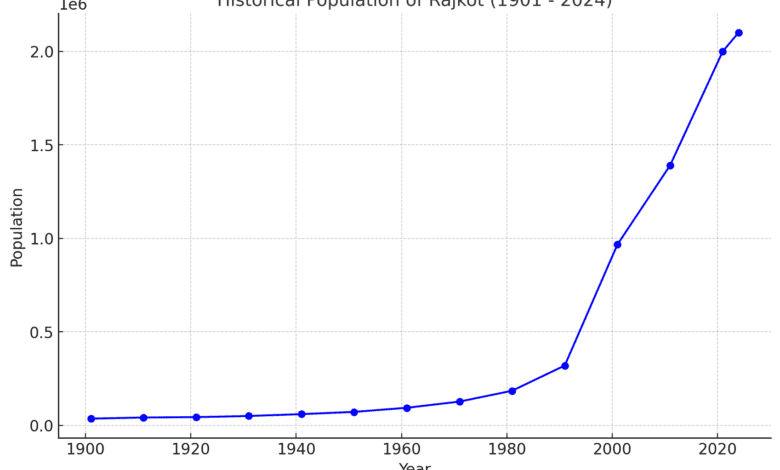Rajkot Historical Population: Overview from 1901 to 2024

Early History and Foundation of Rajkot
Establishment: Rajkot was established in 1620 by Thakore Sahib Vibhaji Ajoji Jadeja of the Jadeja clan. The city’s early population consisted primarily of Rajputs, along with traders and farmers who contributed to its agricultural economy.
Strategic Location: The city’s strategic location in the Saurashtra region facilitated trade and commerce, attracting migrants from nearby areas. This contributed to the steady growth of the population during its early years.
Rajkot Historical Population of 1901 to 2024
Rajkot, a city that blends its rich history with rapid modernization, has witnessed significant demographic changes over the past century. Understanding the historical population growth of Rajkot from 1901 to 2024 offers insight into the city’s evolution, its economic transformations, and the forces shaping its future. In this blog post, we will explore Rajkot’s historical population trends, key factors influencing its growth, and the implications of these changes for its development.
Rajkot in 1901: A Small City with a Rich History
In 1901, Rajkot was a modest town, home to approximately 36,000 people. The city’s historical population at this time was reflective of its role as a small princely state in Gujarat, under British rule. Rajkot’s population during this era was primarily composed of traders, artisans, and administrators, benefiting from the city’s strategic location in the Saurashtra region.
Population Growth in the Early 20th Century (1901-1941)
Between 1901 and 1941, Rajkot experienced a steady increase in its population. By 1941, the population had grown to around 80,000. This growth was driven by the expansion of trade and commerce, particularly as Rajkot developed into a significant center for textiles and handicrafts. The British influence during this period led to the establishment of educational institutions, administrative offices, and infrastructure, attracting more people to the city.
The historical population growth of Rajkot during this period reflected the broader economic changes taking place across India, as new opportunities emerged in urban centers like Rajkot.
Population Growth During the British Era (1800s-1947)
- British Influence: Rajkot became a British administrative center in the late 1800s, contributing to its infrastructural development. This period saw the establishment of schools, railways, and administrative offices, leading to a rise in the city’s population.
- Census Data of 1901: The population of Rajkot was recorded to be around 36,000 during the 1901 census, reflecting a slow but steady growth.
- Migration Patterns: The British era brought in diverse communities such as Parsis, Muslims, and others from different parts of India, further enriching the demographic fabric of Rajkot.
Post-Independence Boom: 1947-1971
The population of Rajkot surged in the post-independence era, as India embarked on a path of rapid urbanization and industrialization. By 1971, Rajkot’s population had grown to approximately 300,000. The establishment of various industries, particularly in the engineering and manufacturing sectors, contributed significantly to this population growth. Rajkot became a hub for small and medium-scale industries, which created job opportunities for thousands of people.
The post-independence historical population boom in Rajkot was also driven by rural-to-urban migration, as people moved to the city in search of better economic prospects and improved living standards.
The Influence of Industrialization in the 1980s
The 1980s marked a pivotal period in Rajkot’s historical population growth. By 1981, the population had crossed the 500,000 mark. The city saw increased industrialization, with industries ranging from textiles to machine tools thriving in Rajkot. The rise in employment opportunities and the city’s improved infrastructure attracted migrants from neighboring towns and villages.
Rajkot’s historical population during this period was heavily influenced by the city’s emergence as a significant economic center in Gujarat, driving both urban expansion and population density.
Economic Liberalization and Its Impact on Population Growth in the 1990s
The economic liberalization of India in the early 1990s brought profound changes to Rajkot. The city saw an influx of investment, which further spurred industrial growth. By the end of the 1990s, Rajkot’s population had swelled to over 1 million. The historical population growth during this decade was propelled by the establishment of new industries and the growth of sectors such as auto parts manufacturing and software services.
As Rajkot’s economy diversified, its population continued to grow, making the city a vital part of Gujarat’s economic framework.
Modern Era (1991-2020)
- Population Boom: The 1990s marked a period of economic liberalization in India, which impacted Rajkot’s growth. The city’s population increased rapidly due to improved trade links and industrialization. By the 2001 census, the population of Rajkot city was around 1.2 million.
- The 2000s: Rajkot’s Expansion and Urbanization: Rajkot’s historical population continued to grow at a rapid pace during the 2000s. By 2011, the population had reached approximately 1.3 million. This growth was facilitated by the city’s ongoing urbanization, improvements in transportation networks, and the rise of the real estate sector. Rajkot expanded its boundaries, absorbing nearby rural areas into its metropolitan limits. The historical population trends during this period also reflect the broader shift in India towards more concentrated urban growth, with cities like Rajkot absorbing a large share of rural migrants.
- Expansion of City Limits: The municipal boundaries of Rajkot expanded during this period to include surrounding villages and suburban areas, which increased the official population figures.
- 2020 Census Data: According to the 2020 estimates, Rajkot’s population crossed 1.8 million, driven by both natural growth and migration from smaller towns and villages within Saurashtra.
Migration Patterns and Their Role in Population Growth
Migration has played a crucial role in shaping Rajkot’s historical population growth. Throughout the 20th and 21st centuries, people from across Gujarat and other parts of India migrated to Rajkot in search of better job opportunities and living conditions. The city’s flourishing industrial sector, along with its reputation as a center for education and healthcare, has made it a popular destination for migrants.
This influx of people has not only driven population growth but has also contributed to the cultural diversity of the city, making Rajkot a melting pot of various communities.
The Demographic Profile of Rajkot: Age, Gender, and Ethnicity
As of 2024, Rajkot’s historical population is estimated to be around 2.1 million. The city’s demographic profile reveals a young and dynamic population, with a median age of around 28 years. The gender ratio in Rajkot has remained relatively balanced, with slight variations over time due to migration patterns and economic opportunities.
Ethnically, Rajkot is a diverse city, with significant populations of Gujaratis, Marwaris, and people from other parts of India. This diversity has contributed to the city’s vibrant cultural scene, reflecting its historical population growth and the integration of various communities.
Infrastructure Development and Its Impact on Population Growth
The rapid population growth in Rajkot has been accompanied by significant infrastructure development. Over the years, the city has expanded its road networks, improved its public transportation system, and developed new residential and commercial areas. These developments have played a crucial role in accommodating Rajkot’s growing historical population.
In recent years, the city has also focused on sustainable urban development, with initiatives aimed at improving waste management, water supply, and energy efficiency to support its burgeoning population.
Rajkot’s Role in Gujarat’s Economic Growth
Rajkot’s historical population growth has closely paralleled the city’s economic rise. As one of Gujarat’s major industrial and commercial hubs, Rajkot has played a vital role in the state’s economic development. The city’s thriving industries, including textiles, engineering, and auto parts, have attracted both skilled and unskilled labor from across the region.
This economic growth has had a direct impact on Rajkot’s population, as more people have moved to the city to take advantage of its economic opportunities and improved quality of life.
Projections for Rajkot’s Population in 2024 and Beyond
As of 2024, Rajkot’s historical population stands at approximately 2.1 million, and projections indicate that this number could continue to grow in the coming decades. The city’s expanding economy, coupled with ongoing urbanization, is expected to attract even more migrants, both from within Gujarat and other parts of India.
Urban planners are working to accommodate this growth by expanding infrastructure, improving public services, and ensuring that Rajkot remains a livable city for its ever-growing population.
Here’s a summary of historical population data (estimates):
- 1901: 36,000
- 1911: 42,000
- 1921: 44,000
- 1931: 50,000
- 1941: 60,000
- 1951: 72,000
- 1961: 94,000
- 1971: 127,000
- 1981: 185,000
- 1991: 320,000
- 2001: 967,000
- 2011: 1,390,000
- 2021: 2,000,000 (estimated)
- 2024: 2,100,000 (projected)

Rajkot’s Population in 2024
- Estimated Population: By 2024, Rajkot’s population is estimated to be around 2.1 million. This estimation considers the city’s average annual growth rate of approximately 2-3%, reflecting a mix of natural growth and continued migration.
- Demographic Composition: The city’s population is diverse, with a mixture of ethnic communities, including Gujarati-speaking groups, Sindhi migrants, and smaller populations of people from other states.
- Urban-Rural Distribution: While the core urban area of Rajkot houses about 70% of the population, the suburban and rural belts around Rajkot continue to grow as well, providing residential spaces for those working in the city.
Factors Influencing Population Growth in 2024
- Industrial Growth: Rajkot is known for its industrial activities, including the production of bearings, machine tools, and gold jewelry. This economic prosperity has led to a consistent influx of workers and their families, contributing to population growth.
- Educational Opportunities: The presence of higher education institutions, including engineering colleges and medical institutes, attracts students from various parts of Gujarat and neighboring states, boosting the city’s young population.
- Healthcare Development: Improved healthcare infrastructure has led to lower mortality rates and higher life expectancy, contributing to the population increase.
Challenges of Population Growth
While Rajkot’s historical population growth has brought many benefits, it has also presented significant challenges. The city faces issues related to housing shortages, traffic congestion, and environmental degradation. Managing the demands of a growing population while ensuring sustainable development is a key challenge for Rajkot’s urban planners and policymakers.
Efforts are being made to address these challenges through smart city initiatives, sustainable development projects, and investments in public infrastructure, but balancing growth with sustainability remains an ongoing concern.
- Urban Congestion: With a growing population, Rajkot faces challenges such as traffic congestion, pollution, and pressure on existing infrastructure. Managing these challenges is critical to ensuring sustainable growth.
- Affordable Housing: The demand for affordable housing has increased significantly. The city’s municipal corporation has undertaken various projects to address this, but there remains a gap between demand and supply.
- Resource Management: Water supply, waste management, and sustainable use of resources have become key concerns as the population density increases.
Government Initiatives to Manage Population Growth
- Smart City Mission: Rajkot has been a part of India’s Smart City initiative, which aims to improve infrastructure, digitization, and urban planning. These efforts are targeted at making the city more livable despite the rising population.
- Public Transportation Projects: Initiatives such as the Bus Rapid Transit System (BRTS) and the development of new roads have aimed to ease traffic congestion and improve connectivity between urban and suburban areas.
- Affordable Housing Schemes: The Rajkot Urban Development Authority (RUDA) has implemented housing schemes to accommodate the growing middle-class and lower-income groups, ensuring that the city can manage the influx of residents.
Future Projections for Rajkot’s Population (2024-2030)
- Sustained Growth Rate: The population is expected to continue growing at a rate of 2-3% annually, which means that by 2030, Rajkot’s population could approach 2.5 million.
- Focus on Suburban Development: To manage the growing population, future development is likely to focus on expanding suburban areas, with an emphasis on sustainable planning and green spaces.
Conclusion: The Legacy and Future of Rajkot’s Historical Population Growth
Rajkot’s historical population growth from 1901 to 2024 is a testament to the city’s resilience and adaptability. From its modest beginnings as a small princely state to its current status as a thriving metropolis, Rajkot has undergone significant demographic transformations. The city’s population growth has been shaped by economic opportunities, migration, and urbanization, and it continues to evolve as one of Gujarat’s key urban centers.
As Rajkot moves into the future, its historical population growth offers valuable lessons for city planners and policymakers. The city must balance its economic ambitions with the need for sustainable development, ensuring that it remains a vibrant and livable place for generations to come.
Rajkot’s historical population trends reflect a story of transformation from a small princely town to a thriving industrial and cultural hub. The city’s population growth is influenced by a blend of economic opportunities, educational institutions, and strategic location within Gujarat. As Rajkot navigates the challenges of urbanization in 2024, it remains a testament to the resilience and adaptability of its people. Sustainable urban planning and inclusive growth will be key to ensuring that the city’s vibrant history continues to shape a promising future.
Frequently Asked Questions (FAQs)
1. What was Rajkot’s population in 1901?
In 1901, Rajkot’s historical population was approximately 36,000. It was a small town under British rule, primarily known for its trade and administrative importance.
2. How did Rajkot’s population grow after independence?
Rajkot experienced rapid population growth after India’s independence in 1947. By 1971, the population had reached around 300,000, driven by industrialization and rural-to-urban migration.
3. What industries contributed to Rajkot’s population growth?
Rajkot’s population growth has been closely tied to the development of industries such as textiles, engineering, auto parts manufacturing, and more recently, IT and software services.
4. What is Rajkot’s estimated population in 2024?
As of 2024, Rajkot’s historical population is estimated to be around 2.1 million, reflecting a century of steady growth driven by economic and social factors.
5. What challenges does Rajkot face due to its growing population?
Rajkot faces challenges such as housing shortages, traffic congestion, and environmental issues due to its growing population. Urban planners are working on sustainable solutions to manage these challenges while ensuring continued development.




